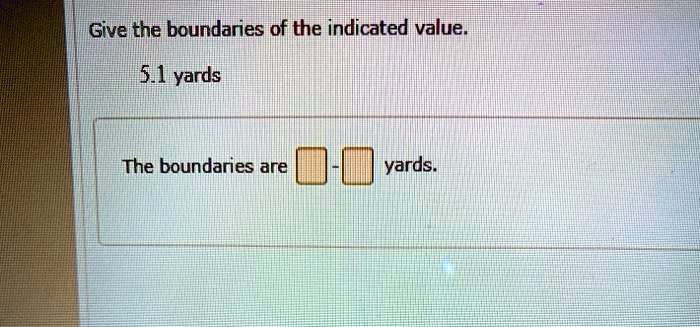Give The Boundaries Of The Indicated Value.

The concept of "boundaries of indicated value" is becoming increasingly crucial in fields ranging from manufacturing and metrology to healthcare and finance. It represents the permissible deviation or uncertainty associated with a measured or reported value, ensuring data integrity and accuracy in various applications.
Understanding these boundaries is essential for making informed decisions, maintaining quality control, and adhering to industry regulations. Failing to account for these uncertainties can lead to flawed analyses, inaccurate product design, or even serious safety hazards.
Defining the Boundaries
The boundaries of indicated value, also known as measurement uncertainty, define the range within which the true value of a quantity is likely to fall. This range accounts for potential errors introduced by the measurement instrument, the measurement process, and environmental factors.
These boundaries are typically expressed as a range around the indicated value, such as "+/- a certain percentage" or "+/- a specific unit of measurement". The specific method for determining these boundaries varies depending on the context and the applicable standards.
Key Components Contributing to Boundaries
Several factors contribute to the overall uncertainty associated with a measurement. These factors can be broadly categorized into systematic errors and random errors.
Systematic errors are consistent deviations that occur in the same direction, often due to calibration issues or inherent limitations of the measurement instrument. Random errors, on the other hand, are unpredictable fluctuations that can vary in magnitude and direction.
Other contributing factors include environmental conditions (temperature, humidity, pressure), operator skill, and the stability of the object being measured. Identifying and quantifying these sources of error is critical for establishing reliable boundaries of indicated value.
Applications Across Industries
The concept of boundaries of indicated value is relevant across a wide spectrum of industries. In manufacturing, it's used to ensure that products meet specified tolerances and quality standards.
In healthcare, understanding the uncertainty associated with diagnostic tests is crucial for accurate diagnosis and treatment.
"Ensuring the accuracy of diagnostic measurements is paramount for patient safety,"states Dr. Anya Sharma, a leading medical researcher.
In finance, it plays a vital role in risk management and investment analysis, where uncertainties in market data must be carefully considered. Financial institutions rely heavily on accurate data and understanding potential fluctuations to make informed investment decisions.
Importance of Standards and Regulations
Various international standards and regulations govern the determination and reporting of measurement uncertainty. These standards provide a framework for ensuring consistency and comparability across different laboratories and organizations.
Organizations like the International Organization for Standardization (ISO) and the National Institute of Standards and Technology (NIST) develop and maintain these standards. Adherence to these standards is often mandatory for accreditation and compliance purposes.
The ISO/IEC 17025 standard, for example, specifies the general requirements for the competence of testing and calibration laboratories. This standard emphasizes the importance of validating measurement methods and estimating measurement uncertainty.
Impact on Decision Making
Acknowledging and incorporating the boundaries of indicated value into decision-making processes can significantly improve the reliability and robustness of outcomes. Ignoring these uncertainties can lead to suboptimal decisions with potentially severe consequences.
For example, if a manufacturing process is designed based on measurements that don't account for uncertainty, the resulting products may fall outside the acceptable tolerance range. This could lead to product recalls, customer dissatisfaction, and financial losses.
Similarly, in medical settings, inaccurate test results due to unacknowledged uncertainty can result in misdiagnosis and inappropriate treatment. Therefore, it's crucial for professionals in all fields to be aware of the importance of boundaries of indicated value and to apply appropriate methods for quantifying and managing uncertainty.
Future Trends and Developments
The field of measurement uncertainty is constantly evolving with advancements in technology and data analysis. New methods and tools are being developed to improve the accuracy and efficiency of uncertainty estimation.
The increasing use of machine learning and artificial intelligence is also expected to play a significant role in automating uncertainty analysis and reducing human error. These technologies can analyze large datasets to identify patterns and correlations that can help refine uncertainty models.
Furthermore, there is a growing emphasis on communicating uncertainty information more effectively to stakeholders. Clear and concise reporting of uncertainty allows users to make informed decisions based on the best available evidence.
In conclusion, understanding and applying the concept of boundaries of indicated value is essential for ensuring data integrity, making informed decisions, and maintaining quality control across various industries. As technology continues to advance, the ability to accurately quantify and manage uncertainty will become even more critical for success.


